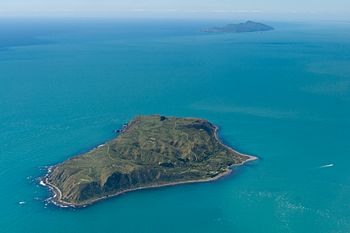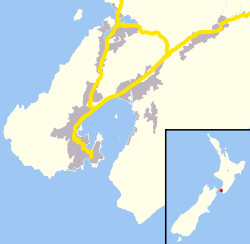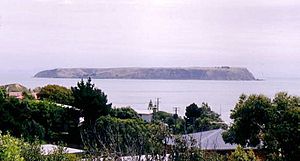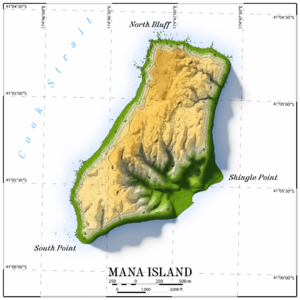Mana Island (New Zealand) facts for kids
|
Māori: Te Mana o Kupe
|
|
|---|---|
 |
|
| Geography | |
| Coordinates | 41°05′15″S 174°46′53″E / 41.0876°S 174.7815°E |
| Area | 2.17 km2 (0.84 sq mi) |
| Length | 3 km (1.9 mi) |
| Administration | |
Mana Island is a special island off the southwest coast of New Zealand's North Island. It's smaller than its neighbour, Kapiti Island. The name "Mana" is a shorter version of the Māori name Te Mana o Kupe. This means "The Mana of Kupe," referring to a powerful spiritual force.
Mana Island is about 3 kilometres (1.9 miles) long. It has a flat top, like a table, with steep cliffs around most of its edges. The island is located about 3 kilometres (1.9 miles) from the North Island coast in the Tasman Sea. It sits west of the city of Porirua. Mana Island is a wildlife sanctuary, meaning no people live there permanently. However, it's officially part of Porirua City. In 2009, experts chose it as one of New Zealand's top places for bringing nature back to life.
Contents
Island History
Mana Island has a long and interesting past.
Early Settlers and Whalers
Māori first settled on Mana Island around the 14th century. In the early 1820s, the Ngāti Toa iwi (tribe), led by Te Rauparaha, set up bases on the island.
Europeans started living on Mana in the 1830s. They set up a whaling station, where they hunted whales. They also cleared much of the island's bush (forest) to create a sheep farm.
A lighthouse was built on the north side of the island in 1863. But sailors sometimes got it confused with another lighthouse. So, a new lighthouse was built on North Brother Island. The Mana Island lighthouse was then moved to Cape Egmont in Taranaki, where it still stands today. In 1865, the island became government property. It was then rented out for farming.
The Vella Family's Farm
In 1886, a man named Mariano Vella took over the lease of Mana Island. He learned how to farm sheep and worked hard to make the island a successful farm. Mariano lived nearby and sailed to the island most days. He even bought an old lighthouse keeper's cottage and rebuilt it on the island. In 1887, he built a small woolshed, which is still there.
Mariano Vella was a very successful farmer. He managed the island farm well. In 1894, he married Elizabetta Caterina Tarabochia. They had two girls and two boys. Mariano retired in 1909 and visited his wife's home in Dalmatia for six years. Later, his son Andrew took over the farm lease until 1951.
Research and Conservation
In 1973, the government bought the lease to use Mana Island for scientific research. They wanted to study special sheep breeds in a safe, isolated place. Over $2 million was spent building labs, barns, and homes for researchers.
However, in 1976, a sheep disease called scrapie was suspected. Many sheep had to be killed. After another possible outbreak in 1979, all 2,000 sheep on the island were removed. The research facility was closed. For the next five years, strict rules were in place about who could visit the island.
In 1986, it was decided that Mana Island should become a place for conservation. All remaining farm animals were removed. In 1987, the island became a scientific reserve. Its care was given to the new New Zealand Department of Conservation (DOC).
Conservation Efforts
Since 1987, Mana Island has been a focus for amazing conservation work.
Habitat Restoration
The first takahē birds were brought to the island in 1987. Then, a seven-month program in 1989 successfully removed all mice from the island. This was important because mice competed with native birds for food.
After the mice were gone, people started planting trees. Volunteers have planted over 500,000 trees! The busiest year was 1996, when about 30,000 trees were planted. Later, a wetland on the island was fixed up. Many rare birds, lizards, and plants have been moved to Mana Island to help them survive.
Studies showed that after the mice were removed, 13 of the island's 22 bird species increased. This was especially true for insect-eating birds.
A ranger from DOC lives on the island to look after it. The island has its own plant nursery, where young native plants are grown. Some old buildings, like the woolshed, now provide homes for native animals. For example, little penguins like to rest under the old woolshed.
The restoration project on Mana Island has involved many people. Groups like the Royal Forest and Bird Protection Society of New Zealand and the Friends of Mana Island, along with school children, have helped a lot. This hard work has made it one of the best ecological restoration projects in Australasia.
Seeds are collected from nearby areas and grown in the island's nursery. Although over half a million native plants have been planted, two-thirds of the island will remain in grass and coastal shrubs. Planting has focused on sheltered areas, as the island can be very windy. The plan is to plant native shrubs in connected areas. This helps birds and allows nature to regrow. Hardy plants that can handle tough conditions are planted first. Once these plants provide enough shelter, other less tough species will be planted to create a typical Wellington coastal forest.
Animals and Their Life Cycles
Mana Island is a scientific reserve that protects many native animals and plants. These species are rare on the mainland. Some important animals on the island include the Cook Strait giant wētā, shore plover, North Island robin, takahē, Wellington green gecko, yellow-crowned parakeet, and brown teal. In 2006, the very rare Wellington speargrass weevil was also brought to the island.
The Department of Conservation and the Friends group worked together to bring the threatened tūturuatu / shore plover to the island. There are only about 200 of these birds left in the wild. Sadly, a rat killed the population in 2011. Another attempt in 2020 failed because of attacks by a kārearea (New Zealand falcon).
Mana Island was once home to kākāpō, which are very rare parrots. The last two males found on Stewart Island were moved to Mana Island in 1995. However, both kākāpō died. This suggested the island might not be the best place for them. But the birds were also very light when they arrived, which might have been a problem.
Future plans include bringing more rare and endangered species to the island. These include the tuatara (a reptile unique to New Zealand), the little spotted kiwi, a type of carnivorous snail called Powelliphanta, and several threatened plants found only in the Wellington Region.
Seabirds and Their Reproduction
Recent projects have successfully moved diving-petrels, fairy prions, and fluttering shearwater chicks to Mana Island. These birds are now nesting and raising their young on the island for the first time in centuries! Seabirds are important because their droppings act like natural fertilizer. Their burrows also provide homes for reptiles and invertebrates (like insects). The methods used to move seabirds to Mana Island are now helping other rare species in New Zealand.
Gannets used to nest on Mana Island. Since 1998, after the mice were removed, conservationists have tried to bring them back. They used fake concrete gannets and played gannet sounds to attract real birds. In 2015, a male gannet, nicknamed Nigel, arrived and tried to court one of the concrete birds. Another male, Norman, lived on the island in 2017. In January 2018, three gannets settled on the island. Sadly, Nigel died in February 2018. These methods are also working well in a similar project near Gisborne.
Island Geology
Mana Island is quite unique compared to Kapiti Island and the nearby mainland. Instead of rolling hills, it has a flat top, like a plateau. This plateau gently slopes towards the southeast. The eastern side has deep valleys, while the north and west sides have cliffs.
Scientists think the plateau might be what's left of an old marine bench. This means it was once a flat area under the sea, and all the material on top has worn away over time.
Climate
| Climate data for Mana Island (1991–2020) | |||||||||||||
|---|---|---|---|---|---|---|---|---|---|---|---|---|---|
| Month | Jan | Feb | Mar | Apr | May | Jun | Jul | Aug | Sep | Oct | Nov | Dec | Year |
| Mean daily maximum °C (°F) | 21.3 (70.3) |
21.8 (71.2) |
20.4 (68.7) |
18.0 (64.4) |
15.9 (60.6) |
13.7 (56.7) |
13.0 (55.4) |
13.7 (56.7) |
14.8 (58.6) |
16.1 (61.0) |
17.7 (63.9) |
19.8 (67.6) |
17.2 (62.9) |
| Daily mean °C (°F) | 17.6 (63.7) |
18.0 (64.4) |
16.7 (62.1) |
14.7 (58.5) |
13.0 (55.4) |
11.0 (51.8) |
10.2 (50.4) |
10.6 (51.1) |
11.7 (53.1) |
12.9 (55.2) |
14.3 (57.7) |
16.3 (61.3) |
13.9 (57.1) |
| Mean daily minimum °C (°F) | 13.8 (56.8) |
14.2 (57.6) |
13.0 (55.4) |
11.3 (52.3) |
10.0 (50.0) |
8.2 (46.8) |
7.4 (45.3) |
7.5 (45.5) |
8.7 (47.7) |
9.7 (49.5) |
10.9 (51.6) |
12.9 (55.2) |
10.6 (51.1) |
| Average rainfall mm (inches) | 60.1 (2.37) |
64.3 (2.53) |
60.3 (2.37) |
72.0 (2.83) |
78.8 (3.10) |
97.5 (3.84) |
102.3 (4.03) |
94.0 (3.70) |
79.7 (3.14) |
100.8 (3.97) |
62.8 (2.47) |
65.9 (2.59) |
938.5 (36.94) |
| Source: NIWA | |||||||||||||
Images for kids




